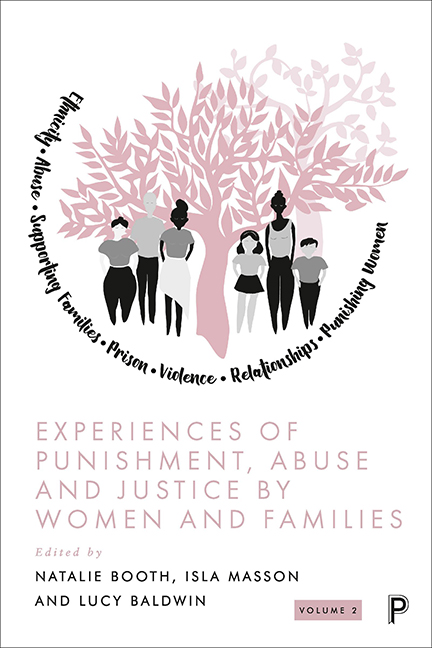Book contents
- Frontmatter
- Contents
- Notes on contributors
- Acknowledgements
- Foreword: time to shift the focus and reduce the use of the penal system for women
- 1 Keeping the conversation going: the Women, Family, Crime and Justice network
- Part I Punishing women in the criminal justice system
- Part II Violence, abuse and justice
- Index
3 - Empowerment or punishment? The curious case of women’s centres
Published online by Cambridge University Press: 18 January 2024
- Frontmatter
- Contents
- Notes on contributors
- Acknowledgements
- Foreword: time to shift the focus and reduce the use of the penal system for women
- 1 Keeping the conversation going: the Women, Family, Crime and Justice network
- Part I Punishing women in the criminal justice system
- Part II Violence, abuse and justice
- Index
Summary
Introduction
This chapter discusses the paradox of women’s centres: are they there to ‘empower’ or to punish? ‘Women’s centres are specialist community support services for women facing multiple disadvantages, including women involved in (or at risk of involvement in) the criminal justice system [CJS]’ (Women’s Budget Group [WBG], 2020, p 3). Women’s centres have existed since the 1970s and there are estimated to be around 50 such centres in England and Wales (Tavistock Institute, 2019). The nature of funding for women’s centres is that of instability; very few have any permanent funding and are thus reliant on winning bids and grants (WBG, 2020). This results in precarity for the workers, and, more importantly, inconsistency for women attending the centres, as well as a motivation to get ‘bums on seats’ to help demonstrate their need for continued funding.
The Corston Report (2007) was a key moment for (re)imagining women’s experiences of the CJS and the need for gender-specific reform. Although much has been critiqued since the report’s publication (see Women in Prison, 2017 for further information), it represents a watershed moment in feminist criminological campaigning for alternatives to women’s imprisonment. Women’s centres existed before Corston yet it was only after the report that their role as authentic alternatives to prison was legitimised. In short, the decades of feminist campaigning and international feminist scholarship was brought mainstream by Corston’s interception. Women’s centres’ clientele consists of women who go there freely, non-statutory, and those who are ordered to go there by the court, statutory. As such, a centre performs conflicting roles: on the one hand, it is there to support women by offering domestic violence (DV) support, education courses, free food, sanitary products, counselling and free legal advice, and, on the other hand, it is there to punish women. This paradox cannot be ignored; for women who go there on a statutory basis experience many of the ‘pains of imprisonment’ (Sykes, 1958) simply displaced on to this alternative site.
This chapter will draw from existing literature and my own observations and auto/biographical reflections of working at one women’s centre in the north-west of England, UK. I will refer to the women’s centre by using the pseudonym River Centre (RC).
- Type
- Chapter
- Information
- Experiences of Punishment, Abuse and Justice by Women and FamiliesVolume 2, pp. 32 - 47Publisher: Bristol University PressPrint publication year: 2023



